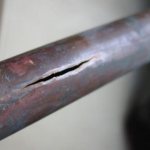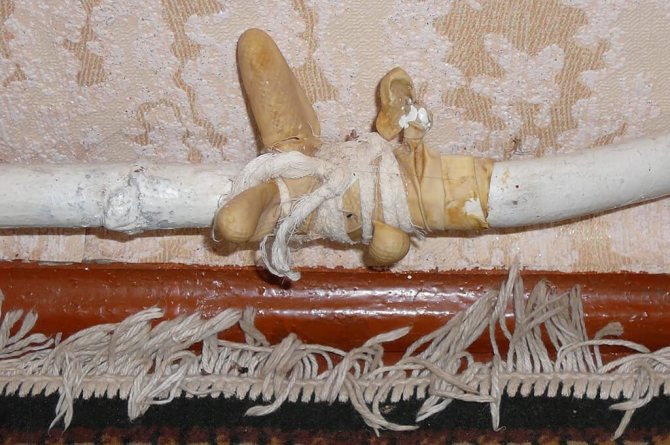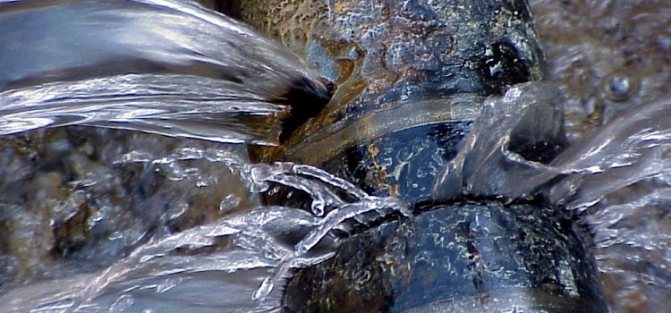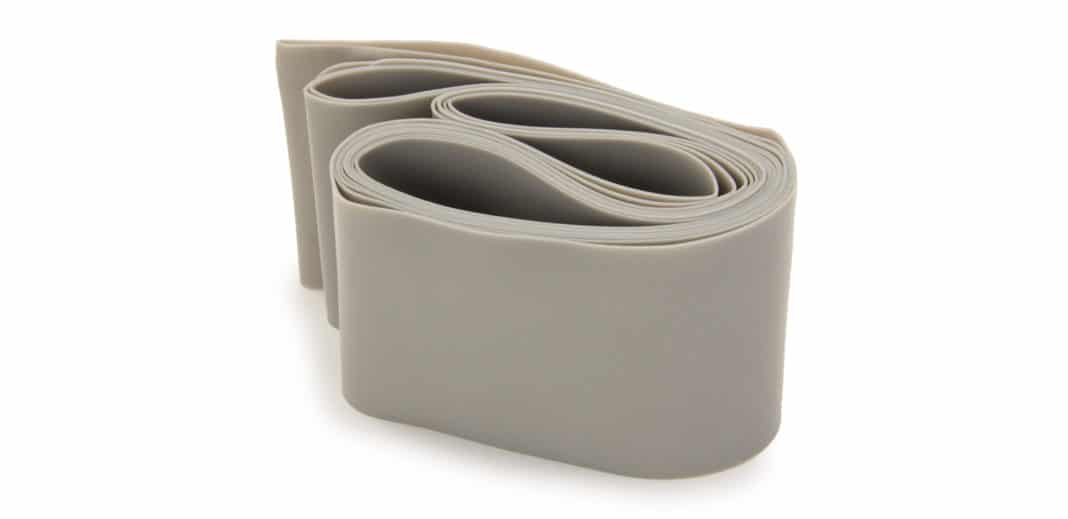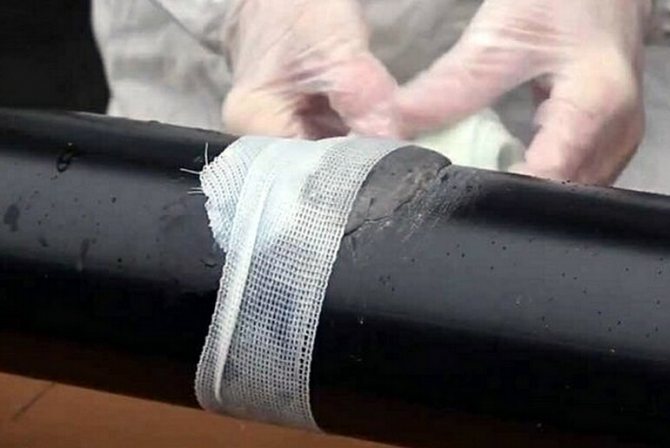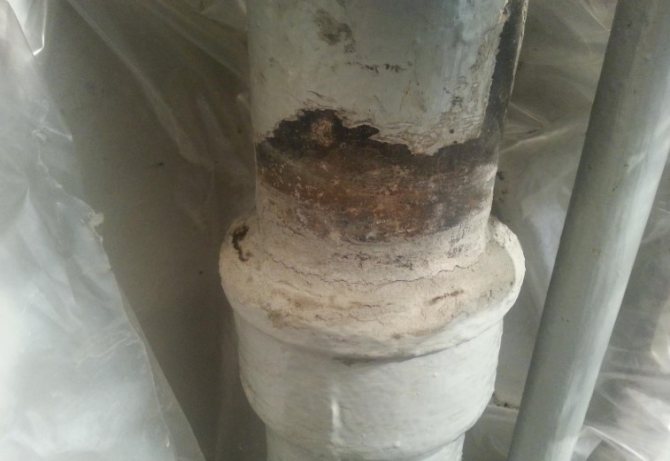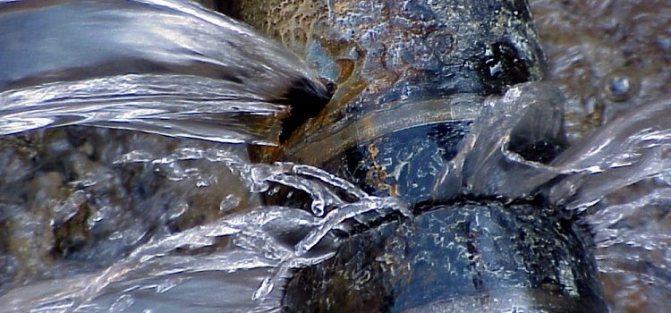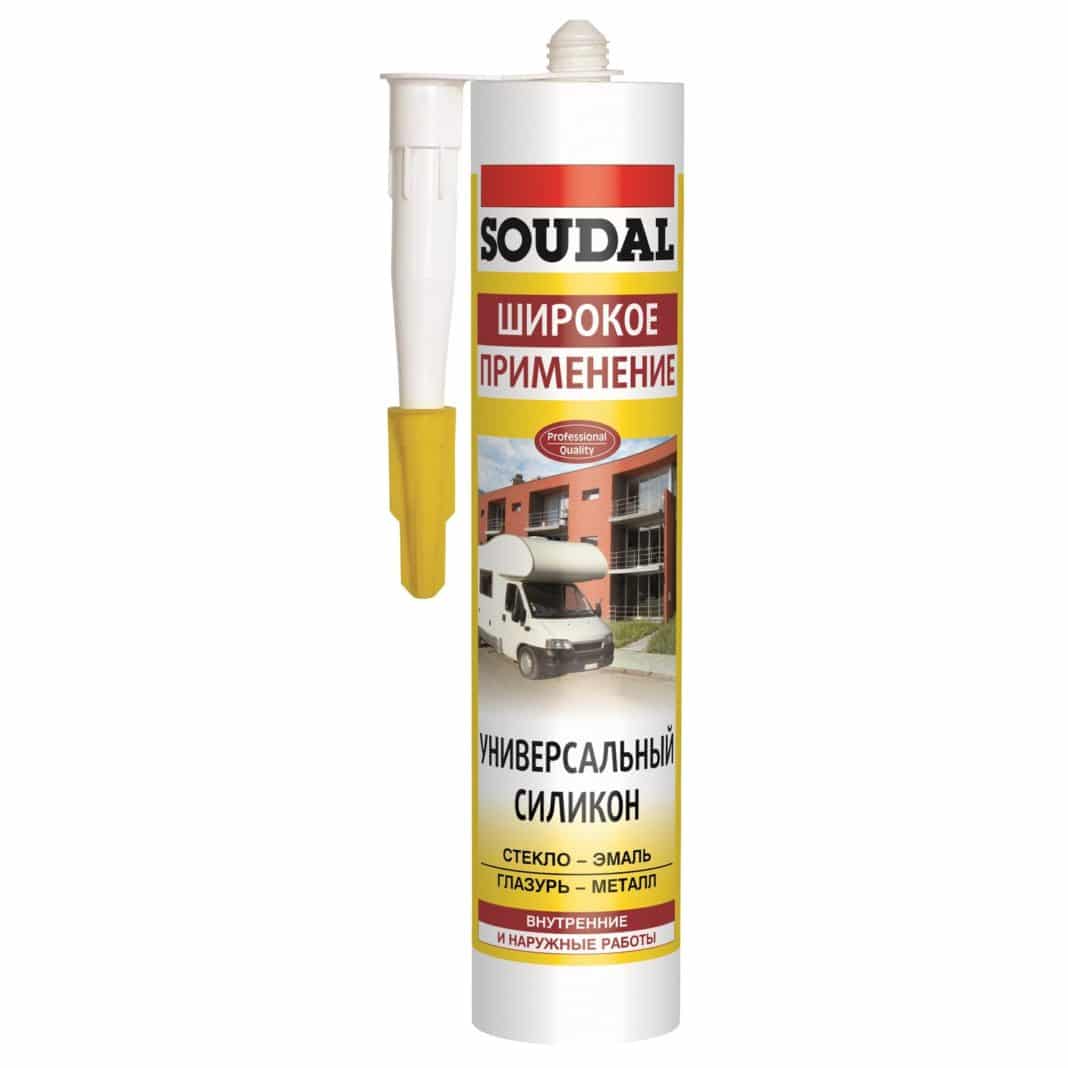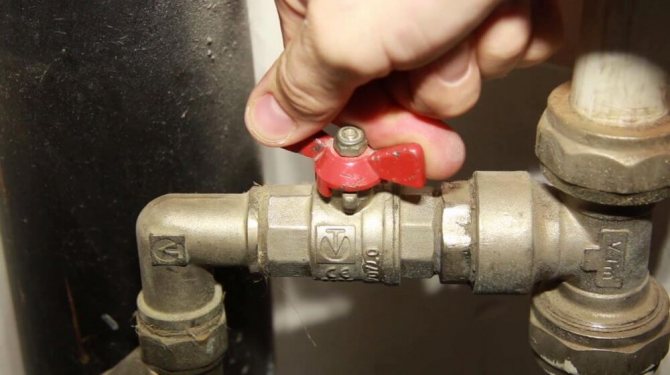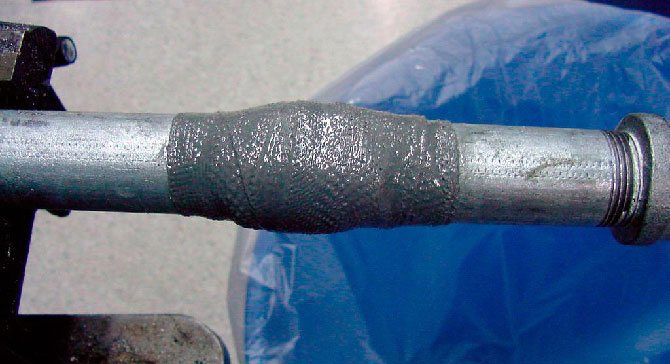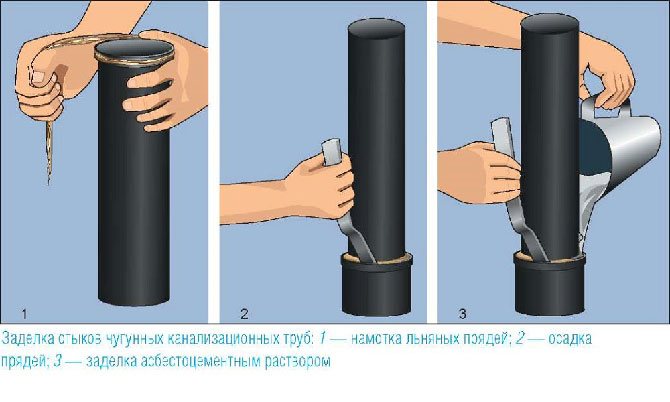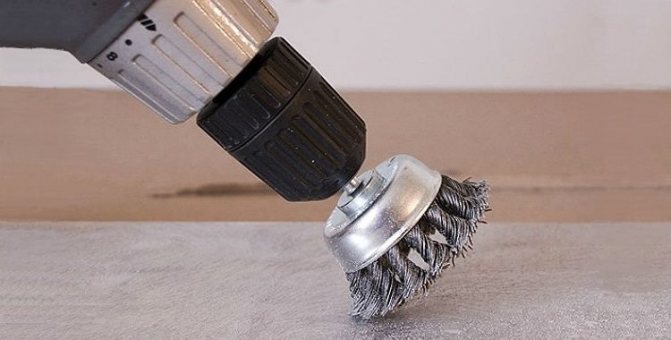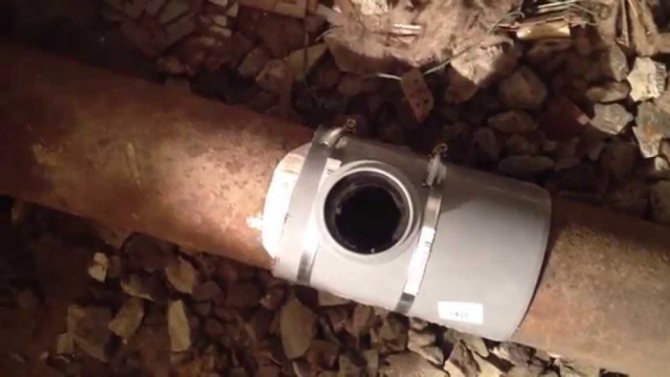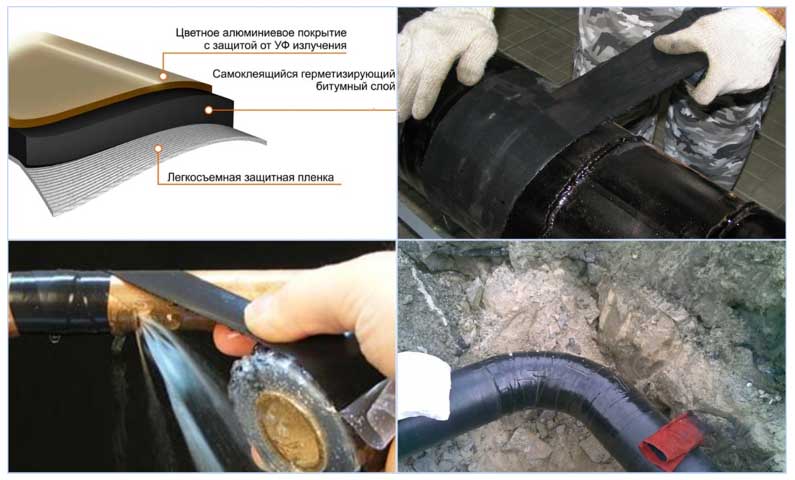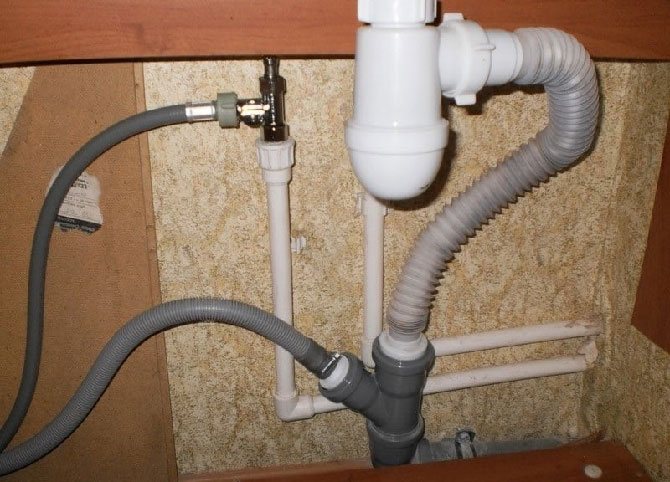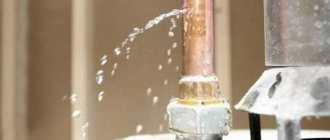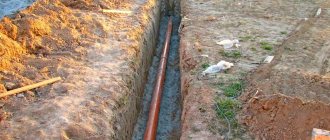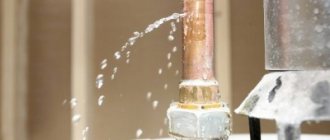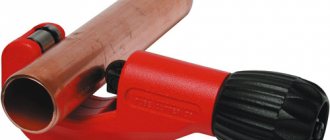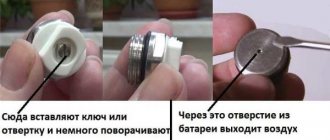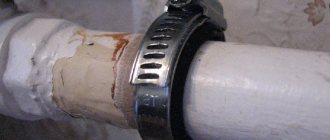Reasons for the appearance of cracks in pipes
A long-operated cast-iron sewage drain in an apartment usually flows for one of the following reasons:
- there was an impact mechanical effect on the metal;
- decrease in wall thickness as a result of prolonged exposure to corrosion;
- destruction of pipeline fasteners and change in the direction of the static weight load;
- simultaneous combination of two or three of the above consequences.
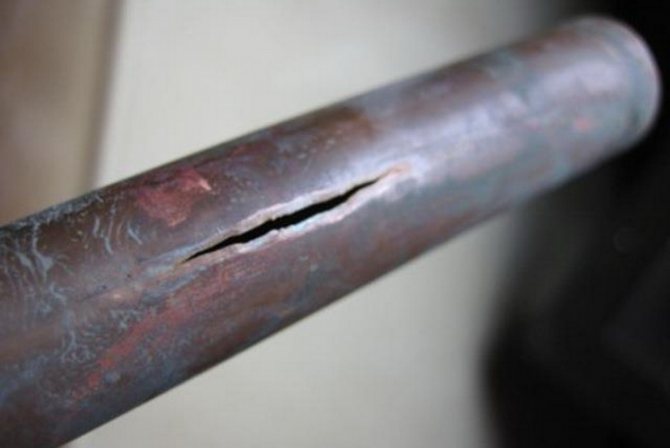
Longitudinal cracks in plastic sewer materials appear only as a result of a lack of compensation for thermal expansion or there was an external shock of great force.
Sealing cracks or holes
Various materials and technologies are used to eliminate defects. The hole in the sewer can be closed using two universal fixing couplings UR-01. Their inner diameter must match the outer dimensions of the pipe.
The use of couplings does not require special tools:
- with the help of a grinder, a part of the pipe is cut out where a crack or hole has appeared;
- rust and dirt are removed from the ends of the pipes to be connected, where the couplings will be located;
- the distance to the middle of the coupling is measured;
- marks are made at the ends of the pipes for the indicated length;
- 2 couplings are wound on both ends of the pipe;
- a new piece of pipe is inserted (must have the same dimensions);
- the couplings move to the new pipe (their ends are located at the level of the marks made);
- using a wrench, the bolts are tightened on the couplings.
You can also plug the hole using a simple rubber sleeve with a seal. In this case, the joints must be covered with cement mortar, followed by paint application.
In such a process, how to repair a crack in a cast-iron sewer pipe, it is not recommended to use improvised means. Chewing gum, plasticine, glue, and other household products will fix the problem only for a short time. It is impossible to correct the situation by driving a wooden (plastic) chopik into the hole. This will cause further damage to the system.
When carrying out repair work, it is forbidden to remove the growths on the pipe, as this will lead to the appearance of a new leak. A large number of rusty growths indicates that in the near future it is necessary to completely change this section of the sewage system.
How to repair a crack in a cast iron sewer pipe with your own hands
In order to eliminate the leak, it is necessary to accurately determine the cause of its occurrence and find the place where it leaks. Depending on this, choose a possible repair method and carry out work. There are several ways to fix a sewer leak. They differ in the level of reliability, the appearance of the pipe after repair, and the complexity of execution.
Method 1. Installing clamps with a rubber gasket
This method of performing repairs requires access to the pipeline with a margin of at least 50 mm from the walls. This condition is very often not met, especially when the pipe is angled in the toilet.
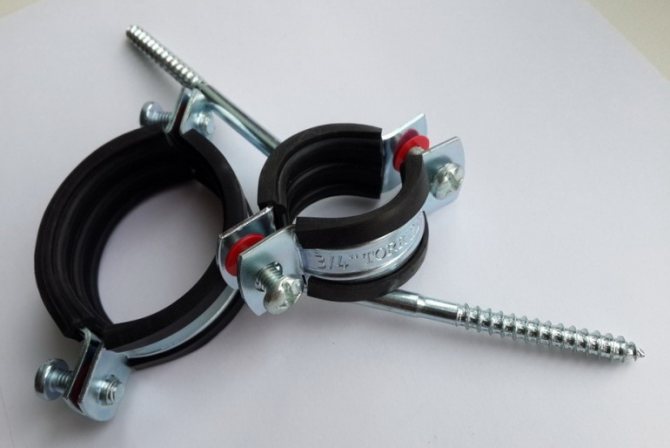

To install the clamp, it is necessary to clean the surface to metal using metal brushes. After that, install a clamp with a rubber gasket.
Method 2. Cement bandage
This is a reliable way to repair longitudinal cracks in non-pressure pipelines. It consists in applying a gauze soaked in cement mortar to the site of damage.
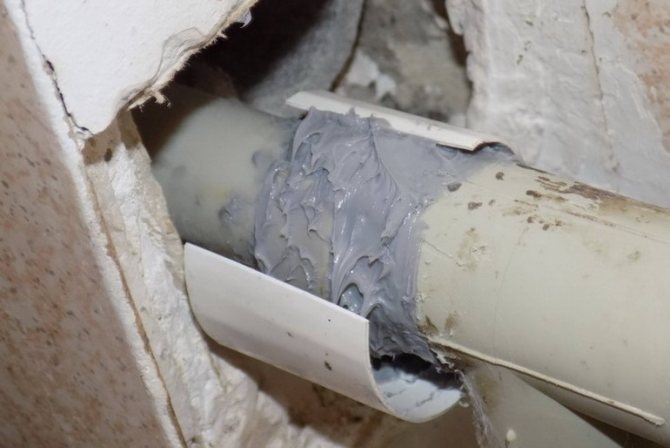

The place to be repaired must be thoroughly cleaned of old paint and rust.Prepare a slurry with the addition of sand in a 1: 1 ratio. Dip the cheesecloth into the solution and make sure it is well saturated with the fabric. Apply the cement bandage to the surface in several layers and tie it with a rubber band or copper wire.
It is recommended to cover the cement surface with liquid glass (silicate glue). This will speed up the setting of the mixture and prevent it from eroding.
Method 3. Application of chemicals
One of the best sealants for sealing cracks and holes in cast iron is a mixture of phosphoric acid and copper oxide powder in a 2: 3 ratio. The prepared solution hardens very quickly and therefore it must be done before the very application to the site of damage.
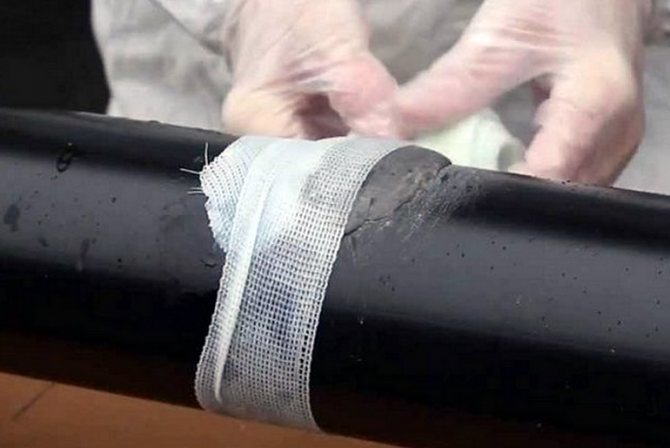

Before covering the crack, the cleaned surface must be degreased with acetone or gasoline.
A solution based on orthophosphoric acid can be replaced with epoxy resin, but its curing time is longer and after application, a surface winding of dense impregnated fabric is required.
Elimination of various types of leaks
Elimination of pipe joint leakage
In case of leaking pipe joints, do the following:
- refuse to use the sewage system for the period of repair work;
- dry the pipe joints well using a rag and / or hair dryer;
- remove the cement mortar from the joint and stamp the gap between the pipes using a linen plumbing tape;
- prepare a polycement mortar from cement, water and PVA glue and coat the joint formed with it in several layers (for the same purpose, you can use a plumbing sealant);
- After completing the specified work, refrain from using the sewage system for a day (when using silicone sealant, the specified time can be reduced to 3 hours).
A situation is also possible when the solution at the joints holds well, and a small leak is observed on its cracks. In this case, the cracks are thoroughly dried and covered up using the same polycement mortar or silicone (plumbing sealant).
Here you can use both children's plasticine and waterproof glue, epoxy resin or raw rubber. What is at home, at hand, will help out.
Elimination of the leakage of the body of the sewer pipe
The case when the sewer pipe is leaking will be more complicated. If there are fistulas in the riser pipes, you should resort to negotiations with neighbors, otherwise you will have to return to repairs repeatedly.
After evaluating the defect and strength of the tube, they choose how to seal the sewer pipe:
- small holes can be closed by using sewer plugs
, in the form of short wooden wedges (long ones will create an obstacle inside the pipe; - with small leaks, you can resort to wrapping the pipe in several layers with gauze, then impregnating it with epoxy;
- you can temporarily eliminate the leak by wrapping the pipe in several layers with rubber bandage and fix the bandage
by making 10-20 tight turns of copper or aluminum wire on top of it (this method is also applicable if a steel water pipe is leaking); - the most reliable will be to use a clamp in this situation
, although it will cost a little more (for pipes with a diameter of 5 cm, a clamp is required, costing from 3 to 8 dollars). In this case, you do not have to think about how to cover up the sewer pipe.
Such plumbing products are not often found in stores, so it is better to visit construction markets, or the best specialty stores.
If circumstances do not tolerate, then you can try and make this useful thing yourself.
Elimination of longitudinal cracks and small chips
There are also critical situations when a longitudinal crack, a small chip, forms on the cast-iron pipe. How to fix a leak in a sewer pipe in this case?
If we are talking about cracks in the exhaust pipes of the riser, then the cause of this situation may be icing of the inner part of the pipe in winter. Frozen water, expanding, often leads to the appearance of such cracks. The long service life of the sewer pipes can also affect.
The absence of an unpleasant smell of sewage gases in the apartment indicates that the cracks have not fully opened. And the presence of condensate at the places of cracks is explained by the fact that it tends to accumulate in the thinnest areas, that is, in cracks. So it seems that the sewer pipe is leaking.
The question arises: how to repair in this case? The answer is quite simple - a sealant will help out great here. First of all, the crack is slightly widened by making a depression for the sealant. Then it is degreased, dried and only then the sealant is applied.
To avoid similar situations in the future, the riser exhaust pipe is insulated in the apartment and in the attic.
If unpleasant odors penetrate through cracks into the apartment, you need to seriously think about how to eliminate the hole in the pipe. In this case, you need to act more decisively. Best of all, such cracks and chips are sealed with a special two-component glue, which is also called "cold welding".
It resembles epoxy resin, but it is more convenient to use, and after curing it lends itself well to grinding, which as a result affects the appearance of the repaired pipe.
And how to cover up the sewer pipe if a crack or chip has formed on the bell?
Moreover, the apartment is located on the first or second floor of an apartment building! Of course, you can't do without a plumber and his wise advice.
The above-mentioned methods of cosmetic repair in especially advanced cases may not help. Then you will have to resort to radical measures - replacement.
So that you do not have to feverishly think about how to cover up a sewer pipe, or a water pipe, constantly monitor their condition.
Before you figure out how to repair a leak in a sewer pipe, you need to understand why it may appear. No one is immune from such a situation, and you need to act as quickly as possible.
This is what a crack in a pipe looks like.
Most often, water flows at the joints of the pipes. The solution to this problem is carried out using organic fiber. It may be necessary to eliminate a leak in a sewer pipe even after a long downtime of the drainage system. This happens with plastic pipes, when the rubber seal gets dry during non-use. Sewerage flows and when there is a mutual displacement of pipes, the compensating pipe most often suffers. It is known that polypropylene and PVC are not resistant to mechanical stress, and if you accidentally drop something heavy on the pipe, then a crack or a whole hole may well form.
Crack in a plastic pipe
The advantage of cast iron is that it does not corrode well, but there is one caveat, the humid atmosphere is poorly tolerated by this material. And if the service life of the cast-iron sewage system exceeds 50 years, then the appearance of through holes is quite likely. Well, the most common cause of a sewer leak is a blockage. They can be a rag, grease plug and even cat litter.
It looks like a leak due to a blockage
How to replace a damaged pipe section
The sewerage system of the apartment consists of a riser and drainage from plumbing and household appliances.
Replacing only the riser in the toilet or individual sections of the horizontal pipe is technically possible, not rational from the point of view of further operation.
Required tools and materials
To complete the work, you will need to purchase a set of parts, which will necessarily include:
- socket pipes with a diameter of 110 mm, lengths of 2000 and 1000 mm;
- transition pipe "cast iron-plastic" 110 × 127 mm;
- compensating coupling (sliding) 110 mm;
- tee or cross, depending on the wiring configuration;
- rubber sealing cuffs 110 × 127 mm;
- three fasteners in the form of clamps;
- assembly grease or sanitary silicone.
From the tool you need to prepare:
- grinder (angle grinder) with a cutting wheel for metal;
- hammer 300-500 grams;
- mount;
- perforator with drilling.
Progress
After the preparatory stage, you can proceed to the direct implementation of the work. First of all, ensure that there is no fecal waste in the riser.
The cast iron riser is cut in stages. First, a window is cut out on the outside with a depth of at least half the pipe diameter. After that, the back wall is cut and the riser can be disassembled.
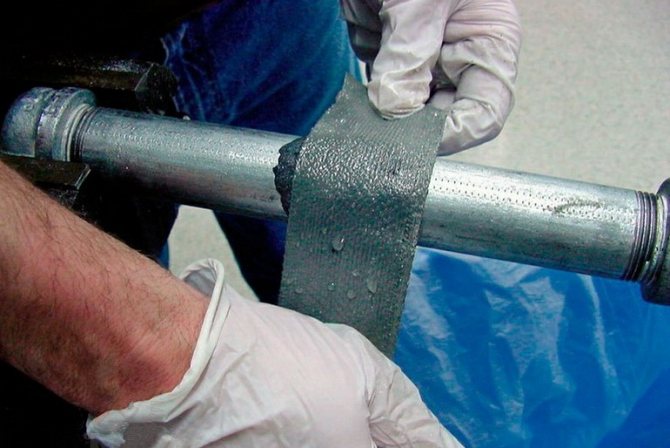

A cast iron-plastic adapter is put on the upper cut of the cast-iron pipe. The bell of a two-meter plastic pipe is pushed onto it, on the lower end of which the compensation sleeve must be pushed to the limit.
A rubber sealing collar is inserted into the lower cast-iron socket and a tee or cross is installed, into which a meter-long pipe is then inserted. Its axis should coincide with the axis of the upper pipe. The movable expansion joint goes down and connects the two parts of the riser. The horizontal lines are routed to the desired sides from the tee or cross.
Cast iron pipe sealing materials
In the sewer system, the joints are the most vulnerable point, therefore, they require increased attention. To seal them, it is customary to use not only linen winding or plaster bandage. There are many more modern and effective materials.
Self-adhesive tape
The material is widely used in plumbing work due to its simplicity, efficiency, resistance to corrosion, and low price. Self-adhesive tape should not be used only in open areas as it is not UV resistant.
Before sealing, be sure to thoroughly prepare the surface of the pipes. They are cleaned of dirt, dust, dried, primed. The tape is wrapped around the desired area with a half overlap. The material is applied in two layers to increase reliability.
Silicone sealants
The material is presented in the form of a special mixture that hardens upon contact with air. Silicone sealants are made from rubber, there are additives to increase the strength and adhesion properties. To increase the polymerization of the mixture, manufacturers add vulcanizing admixtures to the composition.
Silicone sealants are distinguished by high resistance to various temperature conditions, sufficient mechanical strength, moisture resistance, and a long service life.
Other methods of sealing
To increase the reliability of units in the sewer system from cast-iron plumbing pipes, special mixtures are used:
- epoxy resin;
- asphalt mastic;
- technical sulfur;
- cement with asbestos fiber (in a 2: 1 ratio);
- resin strands.
At home, epoxy is most often used. For its hardening, polyethylene polyamine (cold method) or maleic anhydride (hot method) is used. Technical sulfur is suitable for sealing the drainage system. It is pre-crushed, heated and poured into the gap between the pipes.
Expert advice
Eliminating the leak by installing a clamp, bandage or using sealants, it should be understood that if such damage already exists on the pipe, this means that its service life has come to an end and any repair will only be a temporary solution to the issue.
Therefore, immediately after repairing the leak, begin preparations for replacing the entire pipeline as a whole.
Features of the repair of plastic pipes
Unlike cast iron, plastic sewer drains have a smooth outer surface. Therefore, the easiest way to fix a leak on a flat area is to use a special sealed tape, which can be purchased at a building materials store.
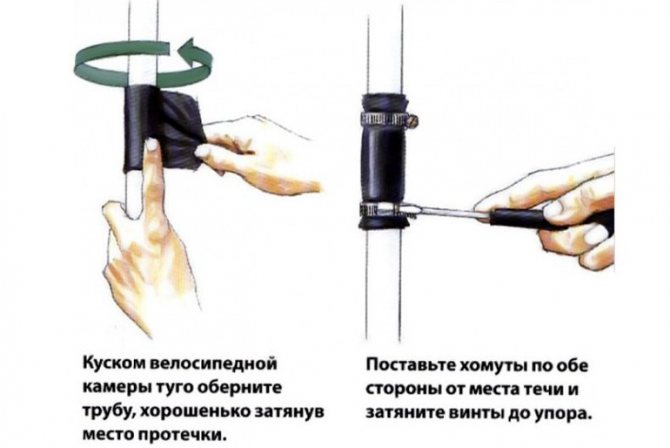

The tape is applied over the hole in such a way that half of its width constantly overlaps the previous strip. Laying is carried out with the maximum possible tension of the material used. The damaged area of plastic pipes should be covered with tape in two layers when winding it in the opposite direction.
For repairs, you can also use a clamping strap and sealants of various compositions.
The cement bandage, due to the low adhesion of the plastic surface, will not adhere to the pipeline.
Nuances of repairing PVC pipes
Since all polymer pipes for internal sewage are made of polyvinyl chloride, the nuances of repairing PVC pipes are no different from the features of repairing plastic pipes, which are described in the previous paragraph.
What to do if there is a leak at the junction of the fitting and the pipe itself
It is necessary to remove the old sealing compound between the inner surface of the socket and the outer wall of the pipe. Then fill the joint with new sealant.
Sealing fistulas in a pipe
Fistulas are formed as a result of corrosive effects on the metal and their sealing is completely analogous to repairing when cracks form, which you can read about above.
How to get rid of an unpleasant smell in a pipe
There will always be an unpleasant smell inside the sewer pipe. This is the nature of faecal effluent.
But in order to prevent the smell from entering the room, it is necessary to ensure the complete tightness of the system, install siphons on all connection points and make sure that they are constantly filled with water.
Plastic or PVC
If there is a small crack or hole in the plastic or PVC pipe, then it can be soldered. If there are too large holes, it is impossible to eliminate the leak by soldering. So how do you practically repair a crack in a plastic, PVC sewer or water pipe?
This procedure is carried out using a polypropylene welding machine, which can be bought at a hardware store. So, first you need to turn on the device, wait until it warms up. At this time, you need to completely get rid of the water in the pipe cavity, dry it. After that, it is necessary to tightly fill ordinary bread (without a crust) into the end of the riser and solder with a hot device. The whole procedure is carried out very quickly - within 10 seconds.
In this case, a special nozzle is used, on the one hand it is thinner, on the other - wider. In this case, they use special polypropylene rods. Such a tool is intended for welding small holes. This can be a cut with a knife, accidental drilling with a drill during construction work, etc.
First it is necessary to drill the resulting hole with a larger diameter drill.
For example, if the pipe was damaged with a drill with a diameter of 6 mm, and you have polypropylene rods with a diameter of 9 mm, then drill a hole with an 8.5 mm drill. After that, take a heated welding machine, thoroughly heat the place of future welding, insert a rod into it, wait a few seconds and remove the machine. After cooling down, after 5-8 seconds, carefully cut off the excess part of the rod. The pressure of the water will easily knock out the remains of the bread.
Cold welding is often used to seal a crack or hole in a PVC pipe. Before eliminating the leak with this special glue, it is necessary to prepare the right place: clean the pipe section from dirt, wash, dry.Then apply glue to the surface, put a patch of rubber of the required size, straighten it well, making sure that not a single bubble appears.
When sealing a crack in a reinforced-plastic pipe, it is best to use a bandage.
This requires:
- buy a bandage together with clamps, taking into account that its width should be 4-5 cm larger than the size of the crack;
- with the help of soft but strong rubber, tightly cover the damaged area, apply and secure the bandage.
In order to seal the crack in the Korsis pipe, use a polyethylene repair plate with an electric heater mounted in it. Interestingly, if such a pipe is in the ground, then the damaged section of the pipeline is not excavated. Special technology makes it possible to carry out repairs underground.

